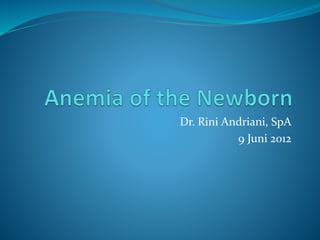
258366488-Neonatal-Anemia.pptx
- 1. Dr. Rini Andriani, SpA 9 Juni 2012
- 2. Definition Anemia, defined as hematocrit (Hct) or hemoglobin (Hgb) concentration >2 SD below mean for age Anemia is defined as Hct <45% in a term infant. A hemoglobin values less than the normal range of hemoglobin for birthweight and postnatal age Physiologic anemia 8-12 weeks in term infants (Hb 11 g/dL) 6 weeks in premature infants (Hb 7-10 g/dL)
- 3. PATHOPHYSIOLOGY May be due to three general causes: 1. blood loss, 2. ↑ RBC destruction or 3. ↓ RBC production.
- 4. CAUSES OF NEONATAL ANEMIA: Blood Loss The commonest cause of neonatal anemia, including: A. Obstetrical causes: placental abruption, placenta previa, trauma to placenta or umbilical cord during delivery and rupture of anomalous placental vessels B. Feto-maternal transfusion: 8% of normal pregnancies have some admixture. C. Feto-placental transfusion due to positioning of infant above level of placenta after delivery, partial cord occlusion (e.g., with nuchal or prolapsed cord).
- 5. D. Twin-twin transfusion •Occurs only with monochorionic (i.e., monozygotic) twins and when there are placental vessels which allow shunting of blood from one twin to the other. •Donor will have anemia of variable severity. •Recipient will have polycythemia of variable severity.. E. Internal hemorrhage such as intracranial hemorrhage, subgaleal hemorrhage,cephalohematoma, adrenal hemorrhage, subcapsular hematoma of liver or ruptured viscus F. Iatrogenic blood loss secondary to sampling of blood for laboratory tests. This is the commonest cause of anemia (and transfusion) in small preterm infants.
- 6. 2. ↑ RBC destruction: A. Intrinsic causes: Hereditary RBC disorders (rare), including: •RBC Enzyme defects (e.g., G6PD deficiency) •RBC membrane defects (e.g., hereditary spherocytosis) •Hemoglobinopathies (e.g., α-thalassemia)
- 7. B. Extrinsic causes: •Immune hemolysis -Rh incompatibility -ABO incompitability -Minor blood group incompatibility (e.g., Kell, Duffy) -Hemangiomas (Kasabach Merritt syndrome) •Acquired hemolysis: -Infection -Vitamin E deficiency (of historical interest, now it is very rare) -Drugs
- 8. 3. ↓ RBC production: A. Anemia of prematurity due to transient deficiency of erythropoietin B. Aplastic or hypoplastic anemia (e.g., Diamond- Blackfan) C. Bone marrow suppression (e.g., with Rubella or Parvovirus B19 infection) D. Nutritional anemia (e.g., iron deficiency), usually after neonatal period
- 9. CLINICAL FINDINGS Pallor Tachycardia Tachypnea Apnea Increase O2 requirement Lethargy Poor feeding Hepatoplenomegaly Jaundice Wide pulse pressure Hypotension Metabolic acidosis with severe anemia
- 10. DIAGNOSTIC EVALUATION of anemia: 1. History: •Family: Anemia, ethnicity, jaundice •Maternal and perinatal: Blood type and Rh; anemia; complications of labor or delivery •Neonatal: Age of onset; presence of other physical findings
- 11. 2. Laboratory Evaluation may include the following, depending history and physical findings: •CBC with platelets, smear and reticulocyte count •Blood group and type, Direct Antiglobulin test (Coombs Test) •Bilirubin (total and direct) •Kleihauer-Betke Test (on maternal blood to look for fetal red cells as evidence of feto-maternal hemorrhage) •Ultrasonogram for internal bleeding (head, abdomen) •Rarely, hemoglobin electrophoresis and RBC enzymes •Bone marrow aspiration is almost never necessary to diagnose anemia in a newborn
- 12. MANAGEMENT Will depend on cause and severity of anemia Prenatal: Diagnosis of significant fetal anemia is unusual except in hemolytic disease of the newborn and Parvovirus B-19 infection. Fetal transfusion may be needed for severe anemia.
- 13. MANAGEMENT . Postnatal: A. Anemia of prematurity: The main methods of management are: •Limit blood drawing for laboratory tests •Treatment with recombinant human erythropoietin (r-Hu-EPO •Transfusion with packed red blood cells (PRBCs) for severe anemia
- 14. B. Other causes of anemia: Treat underlying cause when feasible. C. Severe anemia: With severe, symptomatic anemia, the infant’s cardiovascular system may not be able to tolerate the ↑ blood volume from simple transfusion of PRBCs. In such cases, perform a partial exchange transfusion with PRBCs.
- 15. Volume of PRBCs = (Desired Hct – Patient’s Hct) x weight (kg) x 90 cc/kg for exchange (cc) (PRBC Hct – Patient’s Hct) To calculate the volume of PRBCs to exchange, use the following formula:
- 16. Table. Average hematological values for term and preterm infants. Gestation (weeks) Hct (%) Hgb (g/dL) Retic (%) 37 - 40 57 16.8 3 - 7 32 47 15.0 3 - 10 28 45 14.5 5 - 10 26 - 30 41 13.4 -
- 17. Approach to the Diagnosis of Anemia in the newborn Reticulocyte count Subnormal Diamond-Blackfan anemia (pure red cell aplasia Congenital Infections Congenital leukemia Normal or elevated Coombs test Decrease Hb Concentration
- 18. Immune hemolytic anemia: ABO Rh Minor blood group Coombs test MCV
- 19. MCV Low Chronic intrauterine blood loss a-thalassemia syndromes BLOOD SMEAR Normal Abnormal Rare Miscellaneous causes Hexokinase deficiency Galactosemia Blood loss latrogenic (sampling) Fetomaternal /fetoplacental Cord problems Twin to twin Internal hemorrhage Infection,e.g., HIV Toxoplasmosis CMV Rubella Syphilis Normal or High •Hereditary spherocytosis, •Elliptocytosis, stomatocytosis,I •nfantilepyknocytosis, •Pyruvate kinase deficiency, •G6PD deficiency •Disseminatedintravascular coagulation •Vit E deficiency
- 20. Transfusion Protocol Ht (%) Hb (g/dL) Respiratory support and/or symptoms Transfusion volume < 35 <11 Infant requiring mechanical ventilation (MAP >8cm H2O dan FiO2 >0,4) 15 ml/kg PRBCs over 2-4 hr <30 <10 Infants requiring minimal respiratory support 15 ml/kg PRBCs over 2-4 hr <25 <8 Infants not requiring mec vent but receive supplemental O2 or the following presents: •Tachycardia (180x/min) •Tachypnea (80x/min) •Weight gain <10 g/kg/d with 100 kcal/kg/d •Increase episodes of apnea and bradycardia •Undergoing surgery 20 ml/kg PRBCs over 2-4 hr (divided 2) <20 <7 Asymptomatic and Absolute Retic count <100.000 cells/ul 20 ml/kg PRBCs over 2-4 hr